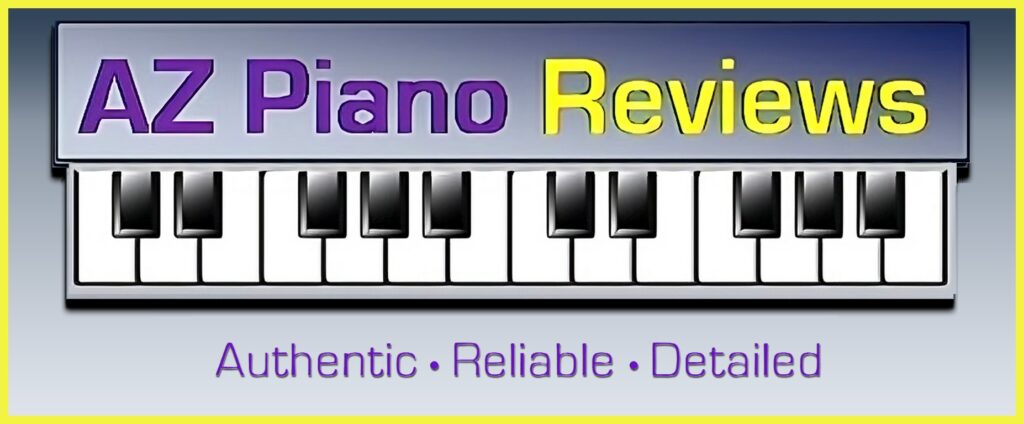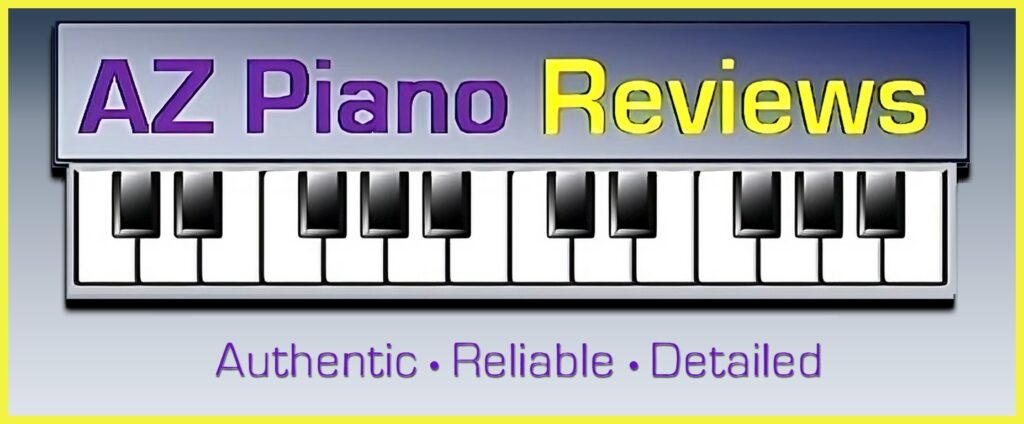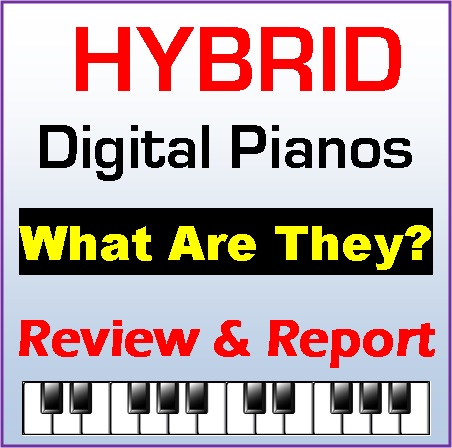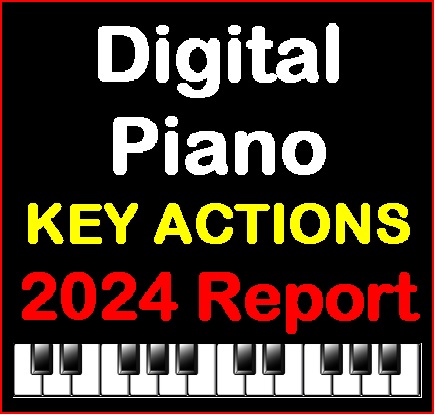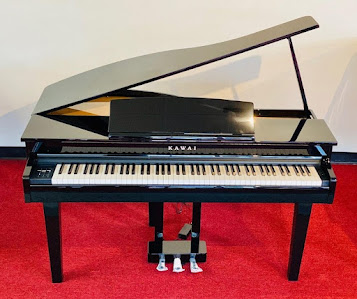 UPDATED REVIEW – June 10, 2024 | Casio AP-S450 Review | Casio AP-550 Review | Home digital piano | 2024 models | $1999 discount price AP-S450 | $2999 discount price AP-550 | Hybrid wood key action | New stereo grand Piano sound engine | Surround speaker system | Modern Cabinet design
UPDATED REVIEW – June 10, 2024 | Casio AP-S450 Review | Casio AP-550 Review | Home digital piano | 2024 models | $1999 discount price AP-S450 | $2999 discount price AP-550 | Hybrid wood key action | New stereo grand Piano sound engine | Surround speaker system | Modern Cabinet design
*This detailed review below is for the new Casio AP-S450 at $1999. At the bottom of this page is my review for the new AP-550 at $2999. The AP-S450 & AP-550 share all the same digital features & functions, but the AP-550 has upgraded cabinet & sound features the AP-S450 does not have.
The Casio digital piano division has just released its newly designed AP-S450 Celviano model. I will refer to this new model sometimes as the “S-450.” This new digital piano by Casio is the first all new home digital piano design that Casio has produced in many years along with new piano reproduction technology.
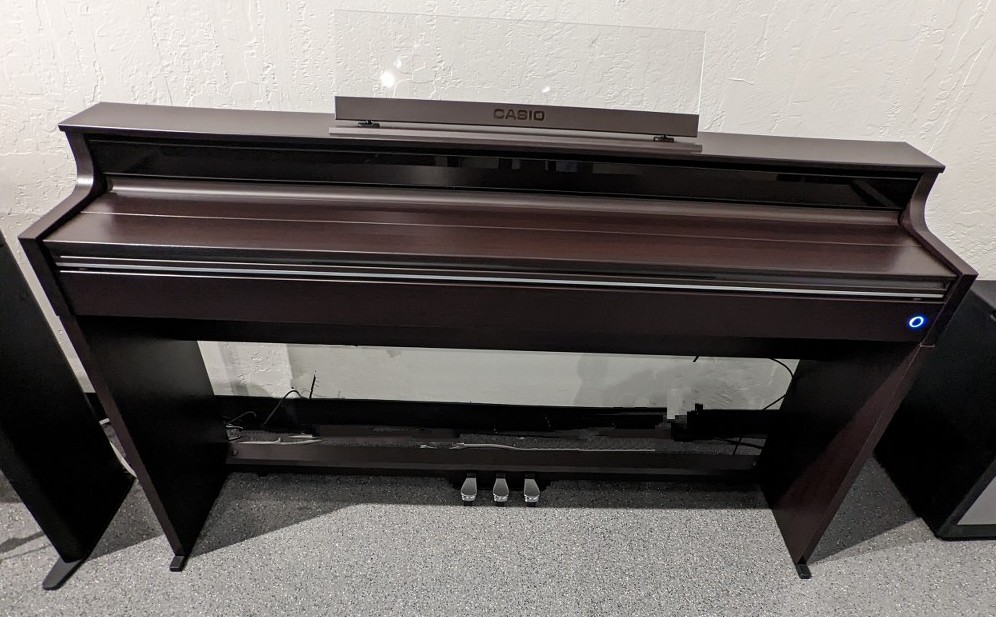
Over the years Casio has had some impressive digital piano models under $2000. But now in this same price range under $2000 there is this new offering from Casio with the AP-S450. The AP-S450 come in 3 new cabinet colors which, in this price range, are quite attractive in my opinion.
This new model comes in a stylish matte black cabinet color, matte rosewood, and matte white cabinet finish, and bench is normally optional. I particularly like the new rosewood finish as it looks attractive, is a darker finish in a wood tone with simulated wood-grain, and Casio has not had a dark rosewood cabinet color until now. But all 3 cabinet colors look great in my opinion.
![]() If you did not know this already, Casio has been producing popular electronic products since the early 1950’s and they have been designing & building digital pianos and keyboards for decades. Casio is a Japanese electronics company based in Tokyo and they have much expertise making digital pianos which have stood the test of time.
If you did not know this already, Casio has been producing popular electronic products since the early 1950’s and they have been designing & building digital pianos and keyboards for decades. Casio is a Japanese electronics company based in Tokyo and they have much expertise making digital pianos which have stood the test of time.
Just so you know, I don’t work for or get paid by Casio for my reviews, nor do I work for or get paid by any of the other brands. I review all of these brands equally and I know these companies very well and what they do. Based on my experience with the Casio products and company, they do a great job with digital innovation as well as produce some impressive pianos.
Even though Casio does not produce standard acoustic pianos like Kawai, Yamaha, Steinway, and others, many of the people who work for Casio are advanced pianists (classical, jazz, pop, etc), they have top musicians who play a number of different instruments, and this company knows what they are doing. Casio is definitely among the top major brands as you will see from this review of the new Casio AP-S450.

HYBRID KEY ACTION
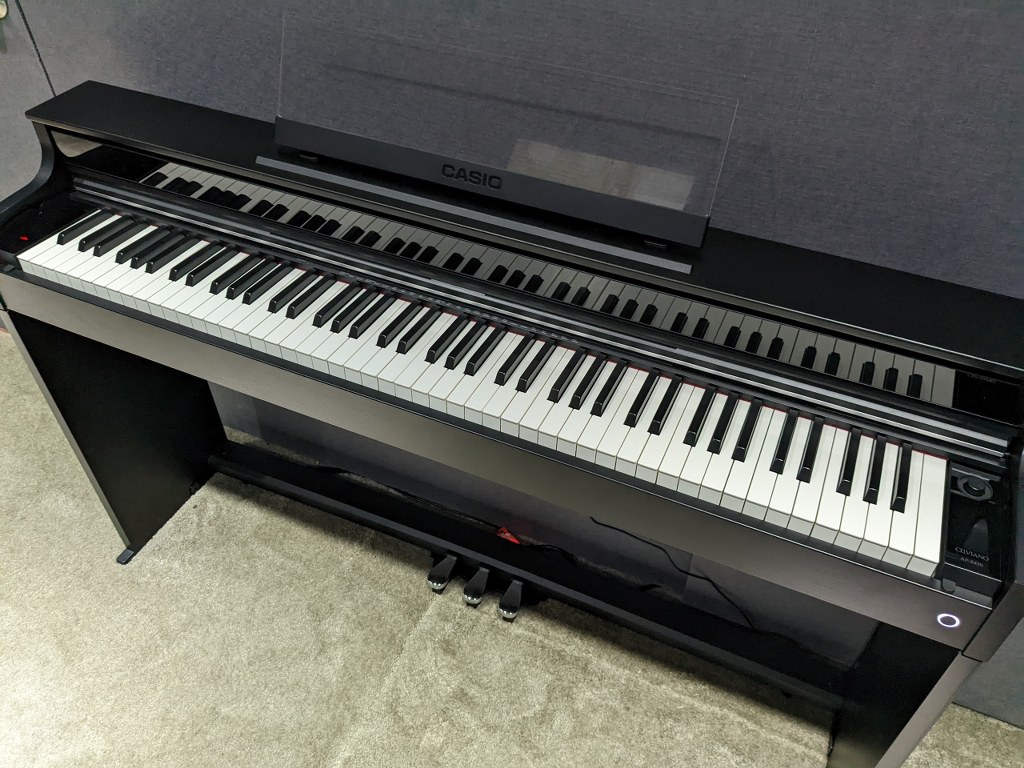
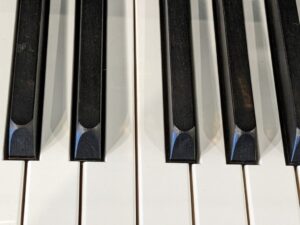
The 1st most important component in any piano is the key action and the way the keys move, respond, and feel. Along with piano sound, pedaling, and internal speaker system, it’s all about the key action. The key action is like the transmission in a vehicle. You want it to be smooth, quiet, responsive, and be dependable.
Casio is using an all new hybrid key action they developed for their professional series PXS portable digital pianos, especially in the PX-S7000 which sells for $2499. This key action is now favored by many professional pianists who want a responsive and more authentic piano key action in a lighter-weight portable digital piano.
So what Casio has done is take this new quality hybrid key action and put it in this new home cabinet model AP-450. Just so you know, a “hybrid” key action is one that is made either completely out of real wood or is a combination of wood and a plastic material of some type.
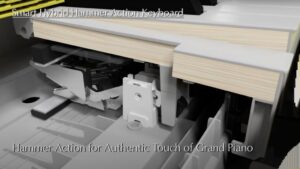 This new Casio hybrid key action is a combination of spruce wood on the outside of the keys and going inward inside the key combined with a durable resin that give the keys more strength. The wood in these keys is not just any old wood, but it is a special spruce wood which is a favored wood in acoustic pianos and acoustic guitars because spruce wood can resonate with vibrations and give the music and playing experience a more natural “feel.”
This new Casio hybrid key action is a combination of spruce wood on the outside of the keys and going inward inside the key combined with a durable resin that give the keys more strength. The wood in these keys is not just any old wood, but it is a special spruce wood which is a favored wood in acoustic pianos and acoustic guitars because spruce wood can resonate with vibrations and give the music and playing experience a more natural “feel.”
By their advertising, Casio is suggesting this key action gives you an “authentic touch of a grand piano.” In fact this key action does not do that and I did not expect it could do that. There is no doubt that this new hybrid key action is very good and is enjoyable to play. But as far as reproducing an actual acoustic grand piano key response and movement, it does not and cannot do that.
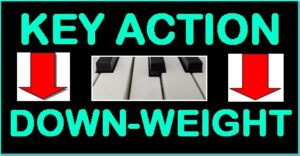 Sometimes these digital piano manufactures (all of them) get a bit carried away in their marketing & ads and say things that ultimately aren’t true. I think most people may not be able to tell if this new Casio key action plays like an acoustic grand or upright piano. Regardless, this hybrid key action is very responsive and feels arguably better than any other the other brands in this price range when it comes to key actions.
Sometimes these digital piano manufactures (all of them) get a bit carried away in their marketing & ads and say things that ultimately aren’t true. I think most people may not be able to tell if this new Casio key action plays like an acoustic grand or upright piano. Regardless, this hybrid key action is very responsive and feels arguably better than any other the other brands in this price range when it comes to key actions.
Based on my measurements, the down-weight force needed for your finger to press down middle C near the front of the key is approximately 54 grams on this model. The finger force needed to press down the C# key is about 49 grams which makes the key lighter to play as compared to the C key. But that’s OK and still comfortable and very playable. So as far as this “touch-weight” goes, I would consider the key action to be a bit lighter than some other pianos (but not too light) and because of that it is very comfortable to play.
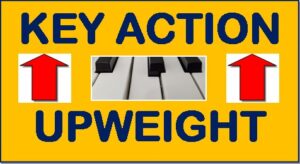 The up-weight strength of the middle C key when coming back to resting position up is approx 39 grams, and on the C# key is about 32 grams. Again, the C# (black) key is lighter than the C (white) key, but it feels good and is very playable.
The up-weight strength of the middle C key when coming back to resting position up is approx 39 grams, and on the C# key is about 32 grams. Again, the C# (black) key is lighter than the C (white) key, but it feels good and is very playable.
Overall this “return force” of the keys (when the keys are coming back up) is a bit stronger than that of a real acoustic grand piano, but it is not too strong of a return force. The keys return quickly so that you get a responsive key movement action. You definitely would not want the keys to return to resting position too slowly or the key action response would be “sluggish” and not desirable.
SYNTHETIC IVORY & EBONY KEY TOPS
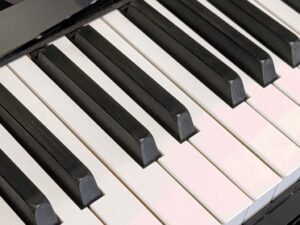 Another benefit to this new key action is the material that is on the key-tops. Casio has a produced a new synthetic “ivory & ebony” material that tries to mimic actual organic ivory and ebony that was put on the tops of the acoustic keys back many decades ago when elephant ivory and ebony trees were still legal and used in various products. Ivory & ebony produced a key surface that was better for playing because of a few reasons.
Another benefit to this new key action is the material that is on the key-tops. Casio has a produced a new synthetic “ivory & ebony” material that tries to mimic actual organic ivory and ebony that was put on the tops of the acoustic keys back many decades ago when elephant ivory and ebony trees were still legal and used in various products. Ivory & ebony produced a key surface that was better for playing because of a few reasons.
Ivory & ebony were porous materials and helped absorb sweat from the fingers which was great for a lot of people. The material also cut down on the glare from plastic key tops and also looked more luxurious. The key tops were a bit smoother and had some texture to it which was helpful when playing. So Casio has produced a similar feel and appearance with their synthetic ivory & ebony key tops.
Those Casio AP-S450 keys look better, feel better, and help absorb sweat from the fingers. So even subtle things like that which add to the quality of the key action have been added to give this model more realism when playing the keys. Casio did a very nice job on the keys in this way.
QUIET KEY ACTION MOVEMENT
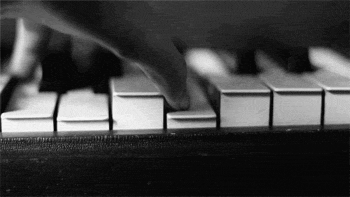 This hybrid key action also creates a noticeably quieter key action movement than in the past and as compared to some other brands which is exactly the experience I had when playing this new model, which I have done many times and for many hours. No other digital piano brand offers a hybrid wood key action under $2000 in a new furniture cabinet style home digital piano and with a relatively quiet mechanism.
This hybrid key action also creates a noticeably quieter key action movement than in the past and as compared to some other brands which is exactly the experience I had when playing this new model, which I have done many times and for many hours. No other digital piano brand offers a hybrid wood key action under $2000 in a new furniture cabinet style home digital piano and with a relatively quiet mechanism.
There are digital piano companies that offer a hybrid key action well over $2000 and mostly above $3000, but not below $2000. So when it comes to an authentic key action experience in a home cabinet digital piano under $2000, I would rate this new AP-S450 above Yamaha, Roland, and Kawai, and also above Korg…but Korg comes the closest to it with there all-plastic key action in this price range.
The new fast-action hybrid key action in the AP-S450 is very responsive and is quieter than compared to some other brands as I have already mentioned, and is overall, a pleasure to play. Plus, it has synthetic ivory and ebony key tops which look great, feel good and help absorb sweat from fingers, and give the keys a classier appearance. So as key actions go, this is a good one and impressive for this price range and I believe most people will like the key movement experience very much on this new model.
PIANO SOUND ENGINE
 The 2nd most important thing in a digital piano is the piano sound. In digital pianos that sound initially comes from recording and/or physical modeling technology. Different digital piano companies use these 2 technologies in various ways. Some do sampling only which is actually recording acoustic pianos with special recording equipment in a music studio, Physical modeling is creating a piano sound from scratch using computerized mathematical algorithms to recreate a piano sound without actually recording it from the real thing.
The 2nd most important thing in a digital piano is the piano sound. In digital pianos that sound initially comes from recording and/or physical modeling technology. Different digital piano companies use these 2 technologies in various ways. Some do sampling only which is actually recording acoustic pianos with special recording equipment in a music studio, Physical modeling is creating a piano sound from scratch using computerized mathematical algorithms to recreate a piano sound without actually recording it from the real thing.
Some digital pianos companies use one or the other technology and/or they use a combination of both technologies. Regardless, all of that technology costs time and money and the piano companies try to give you what they think will produce a reasonably good piano sound. We call that final piano sound the “piano sound engine.”
These companies try to suggest that their technology is the best way and that’s why they do it. Personally I don’t care how they do it, I just want the piano sound to be as authentic as possible in its price range and have great dynamic tonal range, good expression, be “full bodied” and not tinny or too brassy, and be balanced across the keyboard. That’s what I care about.
 So to that end, Casio is using a new sampling technology in the AP-S450 that they have not had in their Celviano digital pianos before under $4000. These new acoustic grand piano sounds are really impressive and much better than I thought they would be as compared to not only other Casio digital pianos under $2000, but also as compared to other brands in this price range.
So to that end, Casio is using a new sampling technology in the AP-S450 that they have not had in their Celviano digital pianos before under $4000. These new acoustic grand piano sounds are really impressive and much better than I thought they would be as compared to not only other Casio digital pianos under $2000, but also as compared to other brands in this price range.
I have compared the piano sound engine in this new AP-S450 to what the other brands have, and in my experienced opinion within this price range for a home furniture cabinet digital piano, the AP-S450 piano sound realism rises to the top.
When it comes to the piano sound realism and character with the organic nuances and elements you would expect to hear in a real good acoustic piano such as balanced, even tone and volume across the 88 keys, great dynamic tonal range from mellow to bright, and a more organic sound instead of being artificial, this new Casio model does a great job especially given its compact form factor.
PIANO POLYPHONY
 One more thing with regard to the piano sound and its realism compared to a real acoustic piano. There is a word called “polyphony.” This specification is typically listed for all digital pianos. Polyphony is the name used to describe how many keys on the piano can be heard all together all at one time without those notes instantly dropping out.
One more thing with regard to the piano sound and its realism compared to a real acoustic piano. There is a word called “polyphony.” This specification is typically listed for all digital pianos. Polyphony is the name used to describe how many keys on the piano can be heard all together all at one time without those notes instantly dropping out.
Polyphony is essentially “piano sound memory,” and the more memory there is for the piano sound in the digital sound chip, the better the piano sound will be. In the Casio AP-S450 there is 256-notes of maximum polyphony which is at the top end of polyphony in digital pianos. 256 notes of polyphony will allow the piano sound to be full and resonant with a lot of natural organic sustain quality.
There are a few other things that go into the polyphony spec, but Casio has done a great job in giving this model the most polyphony it needs to play even very complex pieces of piano music that advanced players would enjoy. Some digital pianos in this price range don’t do as well so it’s good to see that Casio has included this feature in the AP-450 to give it a more natural piano playing experience when it comes to piano sound.
NINE PIANO SOUND SELECTIONS
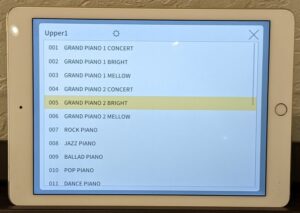 Speaking of piano sounds, there are essentially 9 preset acoustic piano sounds in the AP-S450 including two concert grand piano sounds and then variations of those 2 concert grand sounds. Because of copyright and royalty laws, Casio cannot actually put labels of the actual pianos they used to do their stereo studio recordings.
Speaking of piano sounds, there are essentially 9 preset acoustic piano sounds in the AP-S450 including two concert grand piano sounds and then variations of those 2 concert grand sounds. Because of copyright and royalty laws, Casio cannot actually put labels of the actual pianos they used to do their stereo studio recordings.
Even though the Concert piano sounds are generic on their labels (Concert Piano 1 & Concert Piano 2), to my ears and what I know about them, they are based off recordings of a European Steinway and American Steinway acoustic grand pianos and they sound really good.
Lots of dynamics and expression, great tonal range, and the organic elements in the piano recordings are reasonably even and balanced up and down the keyboard. In fact, to my ears the American Steinway sound sample recording sounds more like a top Yamaha grand piano which normally has a brighter tone than most acoustic Steinway’s I have played. So I liked it very much.
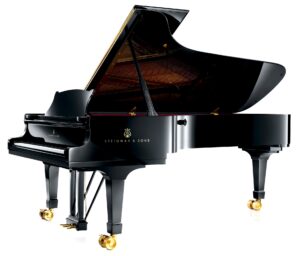 Does this new model sound exactly like a real acoustic piano? The answer is no…none of the brands in this price range can do that. But…does the new AP-S450 come close enough to a real piano to fool many people, even people who play well? Yes it does.
Does this new model sound exactly like a real acoustic piano? The answer is no…none of the brands in this price range can do that. But…does the new AP-S450 come close enough to a real piano to fool many people, even people who play well? Yes it does.
Ultimately that’s what counts. It’s not the manufacturer hype in their marketing materials that you need to focus on, because all the top brands make claims that they have the best, most realistic piano sound. That’s normal for them to say that. But in the end it’s all about what you hear with your ears when it comes to piano sound reproduction and this new Casio model does a great job at its $1999 price.
PIANO PEDALS
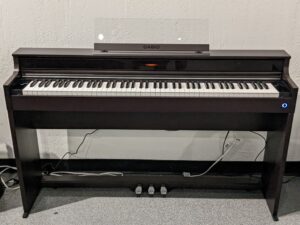 The 3rd most important thing in a digital piano are the pedals. Part of the piano sound that happens in a digital piano is due to the pedals and how they affect the sound, particularly when using the sustain/damper pedal. When you press down that damper/sustain pedal which is the very right side pedal, the piano sound will sustain for a while and be held out and then the piano sound will decay over time as long as you hold down that pedal.
The 3rd most important thing in a digital piano are the pedals. Part of the piano sound that happens in a digital piano is due to the pedals and how they affect the sound, particularly when using the sustain/damper pedal. When you press down that damper/sustain pedal which is the very right side pedal, the piano sound will sustain for a while and be held out and then the piano sound will decay over time as long as you hold down that pedal.
This sustain and decay time can produce a beautiful sustained piano sound useful in just about every type of music. However, just because the piano has a sustain pedal does not mean the pedal works good and that the piano sustained sound will come out right. The sustained piano tone and the way it comes out when using that pedal can vary drastically from one brand & model to the next.
 For the piano sound to be realistic and come out good, the piano sustain technology needs to be done in a way that gives the piano sound a longer decay time which is how much time it takes for the piano sound to fade out when holding down the sustain pedal or holding down a key. Short sustain times when using that pedal make the piano sound fake and artificial.
For the piano sound to be realistic and come out good, the piano sustain technology needs to be done in a way that gives the piano sound a longer decay time which is how much time it takes for the piano sound to fade out when holding down the sustain pedal or holding down a key. Short sustain times when using that pedal make the piano sound fake and artificial.
Some cheaper pianos and off brands can have this issue with the sustained piano tone sounding fake and artificial, and just not enjoyable. Also, it’s not just the length of time it takes for the piano sound to fade away when using the sustain pedal, but it’s also the quality of that piano sound that can be affected with poor pedaling and sound engine technology.
If you are more of a beginner piano player or piano student, then you may not notice the differences with the piano sustaining tone from one model to the next. But as you grow in your piano playing and listening skills then this part of the piano sound will become a very big deal if it doesn’t work correctly. So you need to pay attention to the pedals and what they do and how they work.
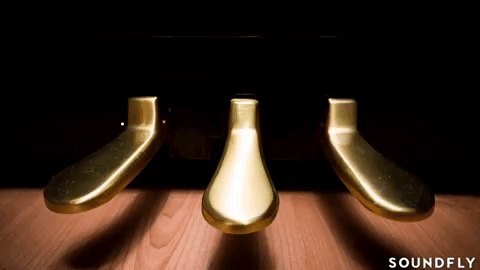 The pedals on the AP-S450 actually work very well, the sustain pedal and sustained piano tone has long decay times and it is enjoyable to use them. The sustain pedal also has the “half-damper” pedal response which allows for variable sustain times depending on how far down you press the sustain pedal. This is also important as a person improves in their playing skills.
The pedals on the AP-S450 actually work very well, the sustain pedal and sustained piano tone has long decay times and it is enjoyable to use them. The sustain pedal also has the “half-damper” pedal response which allows for variable sustain times depending on how far down you press the sustain pedal. This is also important as a person improves in their playing skills.
Because the cabinet on this model is very compact, the pedals are also more compact and not full sized/full length like a real acoustic piano. However, that’s fine, I had no problem using them and they worked well even though they are not full length like other some digital pianos.
If you are a more advanced player like I am then the pedals are still good enough on the AP-S450, but you may still want to move up to a higher end model with larger cabinets and full size pedals like the new Casio AP-550, or AP-750. But apart from that, the triple pedal system on the AP-S450 is quite adequate for its cabinet size.
INTERNAL SPEAKER SYSTEM
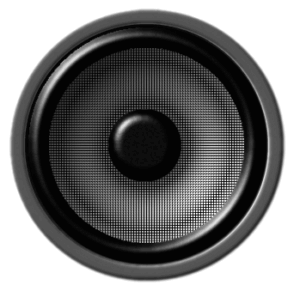 The 4th and final thing that contributes to an enjoyable piano playing experience in a digital piano is the internal speaker system. These components play a big part in the outcome of the piano sound. In a real acoustic piano the piano sound resonates through wooden soundboards and the cabinet of the piano.
The 4th and final thing that contributes to an enjoyable piano playing experience in a digital piano is the internal speaker system. These components play a big part in the outcome of the piano sound. In a real acoustic piano the piano sound resonates through wooden soundboards and the cabinet of the piano.
In a digital piano the piano sound needs to be heard through an internal speaker system. That speaker system consists of speakers, amplifiers, and the physical placement of those parts within the cabinet. Since you typically cannot see the speakers, amps, and other speaker components in a digital piano, then it’s difficult to know for sure how it will sound just by looking at “specs” on a spec sheet.
Some digital pianos have good amplification and other good components, but with cheap tinny sounding speakers. Some have good speakers and weak amplification, some digital pianos have bad speaker positioning within the cabinet, etc. So it’s not all about the “specs” but it’s about the reality of the piano sound when you are hearing it come through the internal speakers system.
When I first tried out this new instrument, because of its compact size I thought the sound through its speaker system might be a bit weak without much volume or clarity. However, to my surprise I found not only was there good volume coming out of the 4 speakers in this AP-S450, but the sound radiated in different directions a bit like surround sound and had good clarity to my ears as I was playing it.
 In other words, it sounded very convincing as a piano through its relatively powerful but compact speaker system. This is very important because in the “under $2000 category” for a digital piano, the way the piano sound comes out of the internal speaker system can make all the difference.
In other words, it sounded very convincing as a piano through its relatively powerful but compact speaker system. This is very important because in the “under $2000 category” for a digital piano, the way the piano sound comes out of the internal speaker system can make all the difference.
In the case of this new Casio model, the main speakers are mounted under the piano and the sound radiates outward through speaker speaker grills as well as the speakers are pointed upward for better stereo piano sound sound distribution.
Then there are two 1.4″ tweeter speakers mounted behind the key cover (when closed) and then filtering the higher frequencies towards the player through micro sound holes and then resonating through the cabinet and the physical keys. It’s a very impressive way to make the piano sound more realistic and organic.
So for a smaller size digital piano with 4 newly designed optimized speakers going through 2 newly designed amplifiers for a total of 40 watts, this piano sounds bigger and better than its size would suggest. However, you do need to play the piano with the master volume control at near maximum output to get the best sound.
I was impressed with the quality of piano sound coming through this new internal speaker system and I believe most people will be very happy with the volume and realism of the piano sounds in the AP-S450 at its $1999 price.
USER INTERFACE CONTROL PANEL

 Every digital piano has a way to access and control its features and functions. Typically these controls are physical buttons that you can see and press on the right side of the keyboard and/or front center of the piano. In the case of this new Casio model, Casio has designed embedded touch senors on the left side panel of the keyboard to control the different functions of the AP-S450.
Every digital piano has a way to access and control its features and functions. Typically these controls are physical buttons that you can see and press on the right side of the keyboard and/or front center of the piano. In the case of this new Casio model, Casio has designed embedded touch senors on the left side panel of the keyboard to control the different functions of the AP-S450.
This new design, which Casio has also been using in a few of their portable piano models, is sleek and useful and easy to see in dark or light areas of the room because each virtual button lights up. When you are not using the control panel then it can be programmed to turn off after a time and then that panel is all black without any buttons showing.
In other words, this new user interface is intuitive, easy to see even in darker areas, easy to use, and makes the piano look much more contemporary instead of “old fashioned.” Beyond that, If you want to instantly select an instrument sound for your song, then you press the “function touch senor button” along with pressing down the appropriate key under the sound you wish to choose. Those sounds can be seen listed in order just above the keys towards the center of the keyboard.
It’s a 2-step process to select a sound. You touch and hold a function button, then when doing that you press a piano key under the specific sound you want on the list above the keys, and then the AP-S450 will play that sound. It’s not hard to do and it’s relatively intuitive. It’s good to know that there is no user display screen to actually see the name of a function or sound in a LED screen like a few other digital pianos have.
CASIO MUSIC SPACE APP
 But…even though I would have preferred a display screen to see what you have selected for sounds or functions, there is something you can do to accomplish the same thing in a much better way. Casio has designed a proprietary app called “Casio Music Space.” You can download this app onto your handheld device or tablet and then control the entire AP-S450 in a much more intuitive way to access all of the many functions and features.
But…even though I would have preferred a display screen to see what you have selected for sounds or functions, there is something you can do to accomplish the same thing in a much better way. Casio has designed a proprietary app called “Casio Music Space.” You can download this app onto your handheld device or tablet and then control the entire AP-S450 in a much more intuitive way to access all of the many functions and features.
Some apps I have used on other brands and models to control their pianos are just OK. But with this new model and app, the ability to interface with the new AP-S450 and the AP-550 goes way beyond what you might expect. This Casio Music Space app makes using and playing this new piano so much more enjoyable…I really like it a lot!
In fact, I like this app and the way it works so much that I will be referring to it often in this review and using images of various app pages to show you what it looks like when accessing these various functions and features of the piano.
GENERAL FEATURES & FUNCTIONS
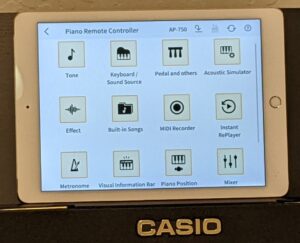 Before I continue there is something that everyone should know about this piano and I just got through talking about it. It’s the Casio Music Space App and here’s why I am mentioning it again. The operating system/user interface on this model is relatively good, but in a lot of cases you need to access the features and sounds by memorizing where they are located on the piano itself and then pressing a function button and then the actual feature or function.
Before I continue there is something that everyone should know about this piano and I just got through talking about it. It’s the Casio Music Space App and here’s why I am mentioning it again. The operating system/user interface on this model is relatively good, but in a lot of cases you need to access the features and sounds by memorizing where they are located on the piano itself and then pressing a function button and then the actual feature or function.
So let’s say you want an instrument sound like strings, electric piano, etc. You need to press the function button on the left side panel and then touch a specific white or black key to trigger/activate that sound. It’s not hard to do but you need to do it in 2 steps along with pressing the correct key to get the sound you want.
With other general features like reverb, metronome, layer, split, acoustic simulator, brilliance, octave shift, transpose, recording, visual info bar, etc, you’ll likely need to refer to the owners manual and see how to access these functions with the use of the function button and then finding the correct white or black key on the keyboard so that you activate that function/feature correctly.
There are many other digital pianos out there which have a similar operating system including Yamaha and Kawai so I have seen this many times before. The lighted side panel on this model is new and proprietary and helps out when pressing one of the embedded touch sensors, but that user interface is still very basic.
With all that being said I want to emphasize that in my opinion the Casio Music Space App will be essential to your overall enjoyment with this piano when wanting to use its many features and functions. This app makes using all the cool features in the AP-S450 a breeze and your ability to use and enjoy the AP-S450 with this app will make it a very satisfying experience. So definitely get the app for your external device (phone/tablet) and you’ll be a “happy camper.”
 There are a total of 26 instrument sounds which includes the acoustic piano tones along with vintage electric piano tones, strings, choirs, organs, harpsichord, vibraphone, and bass. Without the app you would access them by pressing the function button on the piano and then finding the sound you want on the front panel just above the keys and then pressing the correct key to get that sound. IF you want a new sound then you would need to repeat that process.
There are a total of 26 instrument sounds which includes the acoustic piano tones along with vintage electric piano tones, strings, choirs, organs, harpsichord, vibraphone, and bass. Without the app you would access them by pressing the function button on the piano and then finding the sound you want on the front panel just above the keys and then pressing the correct key to get that sound. IF you want a new sound then you would need to repeat that process.
Again, it’s not hard to do but it’s a bit annoying to have to do it that way all the time. With 26 total sounds in this model then that’s a lot of button and key “presses” along with finding the sound you want written just above the black and white keys. With the app you would just go the the instrument sound page of the app and then there is a long list of sounds.

You just touch the sound you want on your device from the app and then that sound quickly and automatically is set to play. So whether it’s a piano sound, organ, harpsichord or whatever, you can get it instantly by touching it on the app. It’s very visual, the sounds are super easy to see, and everything goes quickly and efficiently. If you want to layer (mix) or split 2 sounds at one time, then doing that from the piano itself requires you to look at the owners manual to make sure you know how to do that directly from the keyboard.
 But when using the Casio Music Space app the layering/mixing feature along with the split sound feature is really easy to do and very intuitive. This means you can quickly layer or split any 2 instrument sounds you want to choose and be able to also change relative volume between those 2 instrument sounds so that one does not overpower the other.
But when using the Casio Music Space app the layering/mixing feature along with the split sound feature is really easy to do and very intuitive. This means you can quickly layer or split any 2 instrument sounds you want to choose and be able to also change relative volume between those 2 instrument sounds so that one does not overpower the other.
A lot of times when using the more basic piano interface, these functions are not nearly as easy to figure out and it takes a lot more time to access those features.
So that is another reason I like this Casio app so much because it makes it more enjoyable to use the many features and functions of the AP-S450. Then you can do a lot more with your music and songs in ways that make playing your music a lot more entertaining.
 Personally I like to have a digital piano be as easy to use and understand as possible when trying to access the many features & functions such as all the instrument sounds, layering & splitting the sounds, controlling volume levels, etc. But some people do not have access to an external device, although that’s not near the issue as it used to be.
Personally I like to have a digital piano be as easy to use and understand as possible when trying to access the many features & functions such as all the instrument sounds, layering & splitting the sounds, controlling volume levels, etc. But some people do not have access to an external device, although that’s not near the issue as it used to be.
I think most people these days have access to a digital phone or tablet and they can download the Casio Music Space APP from the app store at no charge and then connect their device to the piano via Bluetooth MIDI wireless or with a cable. It’s easy to do, especially with the capabilities of the new S-450
Then you’ll instantly and intuitively be able to access all the cool features on this new model. Even a 3 year old or 93 year old could do it. There are a few other brands that have their own apps for their digital pianos. But just because there is an app does not necessarily mean it will work good or be intuitive to use.
The Casio company did a great job of designing and implementing this new app so their pianos can be easier to use. Also, using an app to find your sounds on the piano or to access and control other features is easier because your device screen will be larger, it will be in color, and you won’t need to worry about a built-in display screen on the piano ever needing repair because you don’t really need a display screen if you use the app.
Plus, the Casio Music Space app can be updated and upgraded by Casio without negatively affecting the actual piano. So when you read all about this AP-S450 from this review, I will be mostly referring to the app in the images when referring to most features of the piano in that way.
REVERB & HALL SURROUND SOUND MODE
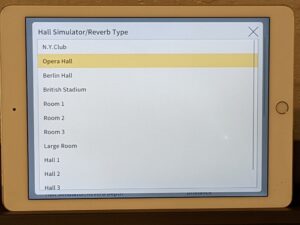 One of the features in many digital pianos that can easily be overlooked is the special reverb effects. Reverb & hall effects can add a lot of “life” and resonance to whatever instrument sound you are using. When playing a real acoustic piano in a room or larger hall, there are natural resonances and ambient sounds which can occur because of the nature of an organic piano instrument and the room it’s being played in.
One of the features in many digital pianos that can easily be overlooked is the special reverb effects. Reverb & hall effects can add a lot of “life” and resonance to whatever instrument sound you are using. When playing a real acoustic piano in a room or larger hall, there are natural resonances and ambient sounds which can occur because of the nature of an organic piano instrument and the room it’s being played in.
These natural resonances can add a lot of life and music al “color” to the music your are playing instead of the sound being more dry and lifeless. This is a big problem with digital pianos that do not have a high quality digital effects reverb/hall system because the piano sounds in cheaper low quality digital pianos can sound like toys and are very artificial in tone.
If you are going to pay good money for a quality digital piano then you’ll want to pay attention to the reverb and hall effects that it has. Even if the specs on that digital piano says it has these features, they can actually be cheap low quality and toy-like in how they effect the piano sound.
 With that in mind, I pay attention to what those reverb and hall effects can do to the piano sound in making either a lot more natural or a lot less natural and artificial. I am happy to report that Casio has done a great job with their upgraded reverb and hall effects system that are easily applied to any instrument sound in the AP-S450, especially as they are applied to the stereo acoustic piano reproductions.
With that in mind, I pay attention to what those reverb and hall effects can do to the piano sound in making either a lot more natural or a lot less natural and artificial. I am happy to report that Casio has done a great job with their upgraded reverb and hall effects system that are easily applied to any instrument sound in the AP-S450, especially as they are applied to the stereo acoustic piano reproductions.
The really nice thing about these special reverb and hall effects are how easy they are to control and apply from the Casio Music Space app. Plus you can “tweak” how much or how little of that effect you want including brilliance, the stereo surround sound, chorus effects for electric pianos, and a lot of other controls for editing those effects.
So you can easily and quickly select how much or how little of that effect (reverb, hall, etc) that you want. Again, using the app makes using these cool features easy to do and contributes to the enjoyment you’ll get from this new piano model.
SONG PLAY, RECORDING MODE, & RE-PLAYER
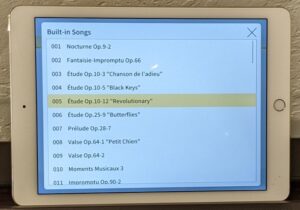 One of the really cool features of the S-450 is its ability to play pre-recorded songs from its 60 song library and then you can play along with both hands or separate the left and right hand part for learning the song. The 60 song library is mostly classical music which I expected. But it does sound good.
One of the really cool features of the S-450 is its ability to play pre-recorded songs from its 60 song library and then you can play along with both hands or separate the left and right hand part for learning the song. The 60 song library is mostly classical music which I expected. But it does sound good.
In addition to that, you can record your own songs with both left and right hand and save them into user song memories inside the piano. Digital user song memory is somewhat rare to have in these digital pianos and there are 10 digital memory slots in which to save songs/music that you have played on the piano.
You can also save an unlimited amount of song recordings to an external USB flash drive which offers a lot of flexibility in how you would save and play songs. You can also import MIDI or audio MP3 or WAV song files from the internet into a USB thumb drive and then automatically play those songs on the piano.
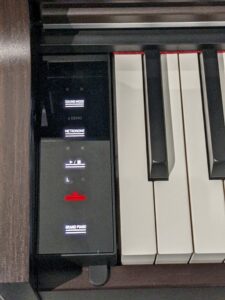 Then you can insert that formatted thumb-drive (it needs to be formatted on the piano first) into the piano and the S-450 will play back those songs for listening pleasure or for you to play along live with those songs. There are many useful ways to do recordings of the music you are playing or practicing on the piano with 2-track MIDI files and 1-track audio WAV files. This is great for educational or recreational purposes and these features are generally.
Then you can insert that formatted thumb-drive (it needs to be formatted on the piano first) into the piano and the S-450 will play back those songs for listening pleasure or for you to play along live with those songs. There are many useful ways to do recordings of the music you are playing or practicing on the piano with 2-track MIDI files and 1-track audio WAV files. This is great for educational or recreational purposes and these features are generally.
The recording and playback feature is accessible from the piano user interface panel and it has a dedicated touch senor recording button on it. So you don’t need the app to do recording and playback because you can do this directly from piano itself. But using the V=Casio music space app can make it more intuitive. When the record button is on it lights up in a red color to indicate it is working.
You can play and record one hand at a time (left/right) and then play them back simultaneously after recording them. This is helpful when practicing a particular song where you want to learn your left & right hand separately. Then after recording each part you can play both recorded parts together at one time to see how it really sounds. This is very useful for educational and practice purposes.
RE-PLAYER FEATURE & VISUAL INFORMATION BAR
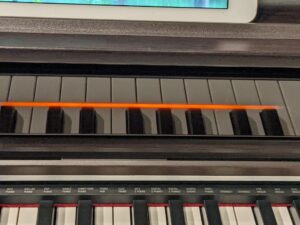 The S-450 has 2 new unique educational features called the “Re-Player” and Visual Information Bar. No other digital piano brand has this new feature. Essentially this “Re-Player is a digital recorder but the difference between this and a regular recorder as I previously mentioned, is the fact that no matter what you play, or when you play it, the S-450 automatically records it because your music is automatically being directed into an instant digital recorder that does not require you to turn it on.
The S-450 has 2 new unique educational features called the “Re-Player” and Visual Information Bar. No other digital piano brand has this new feature. Essentially this “Re-Player is a digital recorder but the difference between this and a regular recorder as I previously mentioned, is the fact that no matter what you play, or when you play it, the S-450 automatically records it because your music is automatically being directed into an instant digital recorder that does not require you to turn it on.
What that means is that anytime you are playing a song, that song is being automatically recorded and then you can just touch play and your previous song/notes will instantly play back to you. The “RePlayer” will also take that recording and show it in digital form as a moving lighted horizontal line (bar) on the front of the piano that moves according to your tempo and velocity of the notes.
Casio calls this moving line (bar) the “Visual Information Bar.” This means that you can visually see this line/bar indication of your tempo and volume of each note by how this moving line appears during the song. This “Re-Player” is primarily for learning and educational visual info to make more apparent as to what you are really doing when playing a song.
 Some people might think this auto-recorder and visual playback system is a “gimmick” and unnecessary when you just look at it superficially. For some people this will be true. But for many other people I believe this new feature will be useful in seeing how you are doing on tempo for any given song you play and also be able to have your music recorded without doing anything
Some people might think this auto-recorder and visual playback system is a “gimmick” and unnecessary when you just look at it superficially. For some people this will be true. But for many other people I believe this new feature will be useful in seeing how you are doing on tempo for any given song you play and also be able to have your music recorded without doing anything
Some people like to “make up” their own music and save it but sometimes you are playing something and you forget to activate a built-in recorder. So the Re-Player simply automatically records and re-plays anything you have played even if you have not set the built-in recorder to record you. Does that make sense? It’s a good way to never loose something
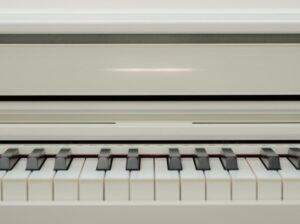
Also, with this new Re-Player, you can start the playback at various points in the song if you just want to hear and playback a certain piece of the song rather than all of it. This additional feature allows you to focus on a part of the song you played and you can play along with live to work on that part of the song that may be more difficult for you. It’s a practice “tool” that can help you learn songs more intuitive way.
So when you see the lighted “visual information bar “line” light up and move to the tempo and dynamics you are playing and shows up on the front panel of the piano, this is what it’s for…to help you “visualize” what’s going on as you play your song. It can be very useful, especially to novice beginner students and people who like to lean in a “visual way” because it gives them a great way to better understand what’s going on when they are practicing or playing a song.
 Also, if you get the black color cabinet for this model, then the light up line is a white into blue and the rosewood color cabinet version has a golden orange color line to contrast more nicely with the cabinet color. On the white cabinet version the moving line is a bright white color to somewhat blend in with the white cabinet. These are small details…but a good ones.
Also, if you get the black color cabinet for this model, then the light up line is a white into blue and the rosewood color cabinet version has a golden orange color line to contrast more nicely with the cabinet color. On the white cabinet version the moving line is a bright white color to somewhat blend in with the white cabinet. These are small details…but a good ones.
The Casio Music Space app also has a specific section to control the features of the Instant Re-Player visualization bar so that you can change parameters of what that lighted bar will do and how it will do it. Having those features on the Casio Music Space app makes this digital bar more practical to use and easier to understand. Again, not everyone will use or care about that visualization bar and it can be shut off. But other people will definitely take advantage of it.
OTHER COOL FEATURES
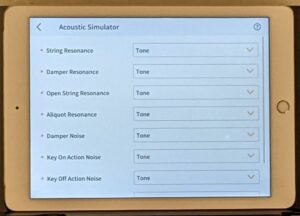 The Casio AP-S450 has a digital metronome to help with rhythm & timing. Most digital pianos have this type of feature so it is not unusual. However, with the Casio piano it is much easier to access and use via the Casio Music Space app. You will have a lot of control that way and be able to set up the metronome for the proper tempo, volume, and time signature.
The Casio AP-S450 has a digital metronome to help with rhythm & timing. Most digital pianos have this type of feature so it is not unusual. However, with the Casio piano it is much easier to access and use via the Casio Music Space app. You will have a lot of control that way and be able to set up the metronome for the proper tempo, volume, and time signature.
There is also an “octave shift” on this model which allows the instrument sound to be placed in higher or lower octaves to achieve different sounds that may be more conducive to your music. You can set any sound up or down 2 octaves, which is good.
You can also transpose your music up or down one full octave by half-steps. Again, this is super easy when using the Casio app, but it can also be done from the piano itself. When doing it from the piano it just takes more time and is not near as intuitive. So your external device will really act as a giant display screen with easier-to-use controls for the various features in this piano.
Even all the piano sounds can be edited in ways that could make the acoustic pianos sounds even more pleasing to your ears. You can control how much or how little you want to have of things like piano hammer response, key-off response, string resonance, damper resonance, key action “noise,” damper noise, and key-off simulator. All of these parameters can be easily edited using the Casio Music Space app along with editing and accessing the “visual information bar” controls, headphone mode, and volume sync EQ settings.
MORE CASIO MUSIC SPACE APP FEATURES
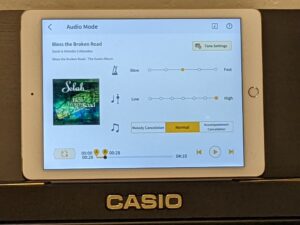 I have been referring to the Casio Music Space app quite a bit when describing different functions & features on the AP-S450 which also apply to the higher price AP-550. There’s a lot to like on the S450 and this app just makes it that much more enjoyable to use. But…there are other musical things this app does that the piano does not do by itself. In other words, the Music Space app adds a lot more features to the S450 that you would not get without this app.
I have been referring to the Casio Music Space app quite a bit when describing different functions & features on the AP-S450 which also apply to the higher price AP-550. There’s a lot to like on the S450 and this app just makes it that much more enjoyable to use. But…there are other musical things this app does that the piano does not do by itself. In other words, the Music Space app adds a lot more features to the S450 that you would not get without this app.
As an example, let’s say you want to learn to play one of your favorite songs. Well, you can download that song into the app from your external device music library using MP3 song files and then that song (or songs) is stored into the app. Then you can play the song back at any tempo and then play along with your favorite song so that you can learn it better. Beyond just playing along with the song, you can manipulate that song through the app.
You can change tempo of that prerecorded audio song and speed it up or slow it down so that you can maybe play along at a slower speed to be able to learn it better that way. Or maybe you want to sing along with the song but your voice is not able to sing in the key of the song. So you can digital transpose the song into any key to fit your vocal range so that you can sing it better! That’s a very cool feature.
You can also “loop” portions of songs and have those portions (specific measures you choose) play back and loop over and over for learning purposes. So when it comes to learning to play music and having fun doing it, this Music Space app does a great job of that.
 Another cool thing the app does is to provide you with a variety of environmental background sounds. The purpose of this feature is to just make it more fun to play music and to engage your mind and senses to make playing music a more enjoyable experience.
Another cool thing the app does is to provide you with a variety of environmental background sounds. The purpose of this feature is to just make it more fun to play music and to engage your mind and senses to make playing music a more enjoyable experience.
An example of this is the interactive venue “applause” feature that duplicates what it would be like to play your music in a club, a big room, a concert hall, etc and have people clapping for you as you play your music.
The clapping and sound of a crowd in the room gives a “live feel” to your music and gives you the sensation that you are actually playing for people in a larger room who are listening to you music. It’s really a cool experience to use these special interactive sound effects and makes it more fun to play.
Another interactive environmental feature on the app are the outdoor special “nature sounds” that you can use. Just imagine yourself playing the Casio AP-S450 at the beach, next to a stream or river, or other natural outdoor places that you might like to be at.
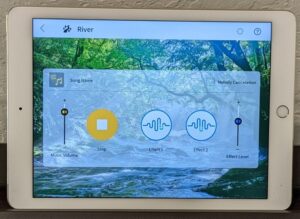 The Casio Music Space app allows you to hear the sounds of the river, forest, ocean waves, etc while you are playing a song on the S450. You can control these different background nature sounds in different ways such as the volume of those effects as well as adding or subtracting different parts of those background sounds such as noises from birds, bugs, seagulls, wave sounds, etc.
The Casio Music Space app allows you to hear the sounds of the river, forest, ocean waves, etc while you are playing a song on the S450. You can control these different background nature sounds in different ways such as the volume of those effects as well as adding or subtracting different parts of those background sounds such as noises from birds, bugs, seagulls, wave sounds, etc.
The point of all this is to simply have more fun with your music while playing and using these environmental effects to liven up your music. It’s great for kids and people of all ages and I really enjoyed it when using these effects while playing some music. They are easy to use, very interactive and they blend in with your music through the speaker system of the piano.
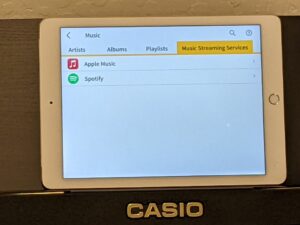 There are other things this Casio Music Space app does such as play songs and give you immediate control over the inner digital functions of the piano. You can even download and play songs from popular music streaming services and then play along with those songs. A lot of young people like to do that and play along. So personally I think this proprietary app is very important to the overall enjoyment of this new piano model. But…using the app is definitely not mandatory.
There are other things this Casio Music Space app does such as play songs and give you immediate control over the inner digital functions of the piano. You can even download and play songs from popular music streaming services and then play along with those songs. A lot of young people like to do that and play along. So personally I think this proprietary app is very important to the overall enjoyment of this new piano model. But…using the app is definitely not mandatory.
You can still get around on the piano and use various features without the app and access instrument sounds, recording features, metronome, transpose, split, layer, etc from the piano control panel. But since I like to use technology and take advantage of things that will help me with my piano playing, then I am personally a big fan of the Casio Music Space app and Casio did a great job of the design and implementation of it.
BLUETOOTH AUDIO & MIDI WIRELESS CONNECTIVITY
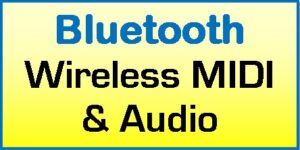 Many digital pianos these days offer Bluetooth wireless audio and/or MIDI connectivity. This feature can be very useful depending on how you use it and if you’ll take advantage of it. Casio offers both MIDI and audio Bluetooth Wireless streaming on this model and they include a free Bluetooth adapter “dongle” with the piano and you just plug it into the piano and you will get instant Bluetooth wireless connectivity with external devices like your phone and/or tablet.
Many digital pianos these days offer Bluetooth wireless audio and/or MIDI connectivity. This feature can be very useful depending on how you use it and if you’ll take advantage of it. Casio offers both MIDI and audio Bluetooth Wireless streaming on this model and they include a free Bluetooth adapter “dongle” with the piano and you just plug it into the piano and you will get instant Bluetooth wireless connectivity with external devices like your phone and/or tablet.
There are a number of ways to interact with Bluetooth wireless streaming such as connecting your a tablet (iPad, etc) or phone to the piano and stream your favorite music on your external device into the piano speaker system. Then you can listen to your favorite music through the impressive piano internal sound system and then play along “live” on the piano to the music that is playing from your external device.
 In addition to that you can also plug in stereo headphones to the Casio AP-S450 and listen to all that music privately through your headphones. There also is a special “headphone mode” in the app to make the sound even more realistic through headphones.
In addition to that you can also plug in stereo headphones to the Casio AP-S450 and listen to all that music privately through your headphones. There also is a special “headphone mode” in the app to make the sound even more realistic through headphones.
The Bluetooth MIDI wireless connection allows you to connect the S-450 to your external device for use with related music apps for learning to play piano, etc without the need for plugging in a cable from the piano into your device. It just makes it more convenient to connect to external devices and use apps to enhance your playing experience.
Just so you know, Bluetooth headphones do not work with any digital pianos pianos because of inherent audio delay in the Bluetooth signal (called “latency”) when playing on the piano keys at the same time. People ask me this question quite often. So just be aware that the piano Bluetooth feature is not for headphones. You’ll needed regular corded headphones for private practice.
CABINET, HARDWARE, WARRANTY
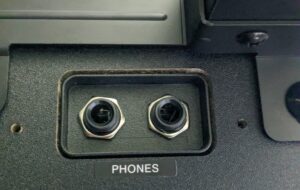 The AP-S450 has some hardware connectivity including two 1/4″ stereo headphone jacks, a USB output to an external device, and a USB input for a thumb-drive memory stick. For most people these hardware ports are usually enough. There are no separate audio output or input jacks on this model. However, the stereo headphone jack can be used as an audio output source.
The AP-S450 has some hardware connectivity including two 1/4″ stereo headphone jacks, a USB output to an external device, and a USB input for a thumb-drive memory stick. For most people these hardware ports are usually enough. There are no separate audio output or input jacks on this model. However, the stereo headphone jack can be used as an audio output source.
Speaking of headphones, when using a good pair of stereo headphones on this piano it really does sound great. A big, full stereo sound coming into your ears and it sounds like a grand piano in your head when using good quality stereo headphones.
The AP-S450 is a very attractive digital piano given it’s smaller compact size. It comes in three very nice cabinet colors including matte black, matte dark rosewood, and matte snow white. The cabinet measurements are 54″ wide x 34″ high, x 12″ deep from the wall. The weight of this piano is 83 lbs so it is fairly lightweight and easy to move.
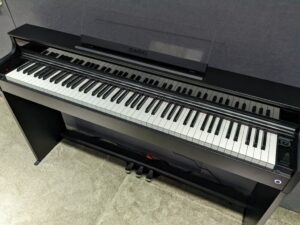 The height of the model is somewhat unusual in that it is taller than most compact digital pianos in this price range giving the AP-S450 a more elegant and piano-like appearance. Beyond the extra added height to this piano, Casio has provided a more elegant glossy finish to that part of the piano in the front. So when looking at the piano from the front, it it noticeably more elegant and “classy looking” than other digital pianos in this price range.
The height of the model is somewhat unusual in that it is taller than most compact digital pianos in this price range giving the AP-S450 a more elegant and piano-like appearance. Beyond the extra added height to this piano, Casio has provided a more elegant glossy finish to that part of the piano in the front. So when looking at the piano from the front, it it noticeably more elegant and “classy looking” than other digital pianos in this price range.
A couple of other cabinet attributes I noticed was the soft close key cover. When you slide the key cover out from its resting place, that key cover comes out and closes slowly over the keys rather than slamming down and making noise. This added slow close mechanism is a nice added touch to the AP-S450.
I also like the design of the music rest . It’s simple and yet elegant with its plexiglass music support and color coordinated bottom piece. So as music racks/desks go, this one looks good and gives good support for sheet music and books.
 A couple of things I want to point out is that there is no back panel on the piano, commonly called a “privacy panel.” so you can see through the S450 from the front of it. Some people do like a privacy panel on the piano, but this this model Casio doesn’t have it.
A couple of things I want to point out is that there is no back panel on the piano, commonly called a “privacy panel.” so you can see through the S450 from the front of it. Some people do like a privacy panel on the piano, but this this model Casio doesn’t have it.
What Casio says about that is because their new internal speaker system with the main speakers mounted under the front of the piano has an omni-directional sound output, a privacy panel would have gotten in the way of the natural sound dispersion and lowered the quality and volume of their new speaker system. So with that in mind, an “open air look” was necessary for this new model and does give the S450 a more contemporary appearance as well.
The AP-S450 also does not normally come with a bench from Casio. There are other brands and models that also don’t come with a bench. For me this is fine because the bench does have a cost and if it is included by Casio with the piano, you are actually paying for the bench…you just don’t know it. If the bench is not included then the piano can be sold for less money, like this one without a bench at $1999.
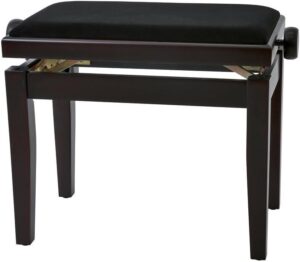 I would personally rather go online on Amazon and buy a better piano style bench with height adjustability and a properly padded bench. Also, I have noticed that some on-line digital piano stores will include a bench sometimes. But those benches are normally cheap metal x-style and/or uncomfortable benches and I personally don’t recommend them.
I would personally rather go online on Amazon and buy a better piano style bench with height adjustability and a properly padded bench. Also, I have noticed that some on-line digital piano stores will include a bench sometimes. But those benches are normally cheap metal x-style and/or uncomfortable benches and I personally don’t recommend them.
So do yourself a favor and purchase a good solid bench on-line on Amazon if you need a bench. That’s a much better way to do it because you will be sitting on that bench often and will want it to be stable, comfortable, and be height-adjustable.
Finally, as with all new digital pianos, the manufacturer offers a factory warranty. In this price range the warranties differ from brand to brand and model to model. Some companies offer just a 1-yar warranty, other companies off 2-years, many offer 3 years parts & labor, and others offer 5 year parts & 2 years labor.
 Other companies offer 5 year parts and 5 year labor, but it is carry-in service where you would need to take the piano to a local technician should the piano need service. With this new Casio AP-S450, Casio not only offers a full 5 year parts & labor warranty, but that warranty includes “in-home” service if you are in an area where there would be a technician available.
Other companies offer 5 year parts and 5 year labor, but it is carry-in service where you would need to take the piano to a local technician should the piano need service. With this new Casio AP-S450, Casio not only offers a full 5 year parts & labor warranty, but that warranty includes “in-home” service if you are in an area where there would be a technician available.
This is somewhat rare to get this kind of long warranty on a digital piano at or under under $2000, so the Casio company must have a lot of faith in the reliability and durably of their product or they would not offer this kind of a warranty in my opinion. Even though the top digital piano companies typically build reliable digital pianos these days, it’s still good to get a longer warranty if possible.
FINAL THOUGHTS & SUMMARY
 Here’s the bottom line. Based on my extensive research and playing time with this new Casio AP-S450, I can definitely recommend it to anyone who wants to primarily focus on piano playing, piano playing education, and get an overall satisfying piano playing experience. With its uniquely attractive cabinet design and outside finish, it should not only be an enjoyable digital piano to play, but it’s also very nice to look at, especially if you want an elegant and yet more contemporary compact “open air” digital piano for your home.
Here’s the bottom line. Based on my extensive research and playing time with this new Casio AP-S450, I can definitely recommend it to anyone who wants to primarily focus on piano playing, piano playing education, and get an overall satisfying piano playing experience. With its uniquely attractive cabinet design and outside finish, it should not only be an enjoyable digital piano to play, but it’s also very nice to look at, especially if you want an elegant and yet more contemporary compact “open air” digital piano for your home.
It’s a very good digital piano for the whole family whether you are a beginner or more advanced piano player. The additional “bells & whistles” are useful for a number of musical needs and reasons and will add to a person’s overall musical enjoyment.

The proprietary Casio Music Space app is especially impressive in allowing you to control the various aspects of this piano in a more intuitive and user-friendly way. With the additional educational and fun features this app provides, it’s a great combination playing this piano along with using the app as a big bonus to your piano playing.
By the way, some people prefer the matte white cabinet color because it looks contemporary and clean and fits in with a lot of the newer home decor. The white cabinet also tends not to show any dust or fingerprints as easily as darker colors do. I do like this cabinet color a lot and it is definitely an option when deciding among the 3 cabinet colors for this model.
Yes, there are other brands and models of digital pianos in this price range at or around $2000. But to get something that looks like this one, sounds and plays like this one, and has the features and functions this digital piano has, you won’t be able to find anything like it elsewhere. If you believe this is the right piano for you then we recommend you buy it, especially if you can find one in stock as it has become very popular, even though it has only been out for a short time. We can also help you with this model as we do with all digital pianos so that you can save even more money.
CASIO AP-550 – UPGRADED MODEL
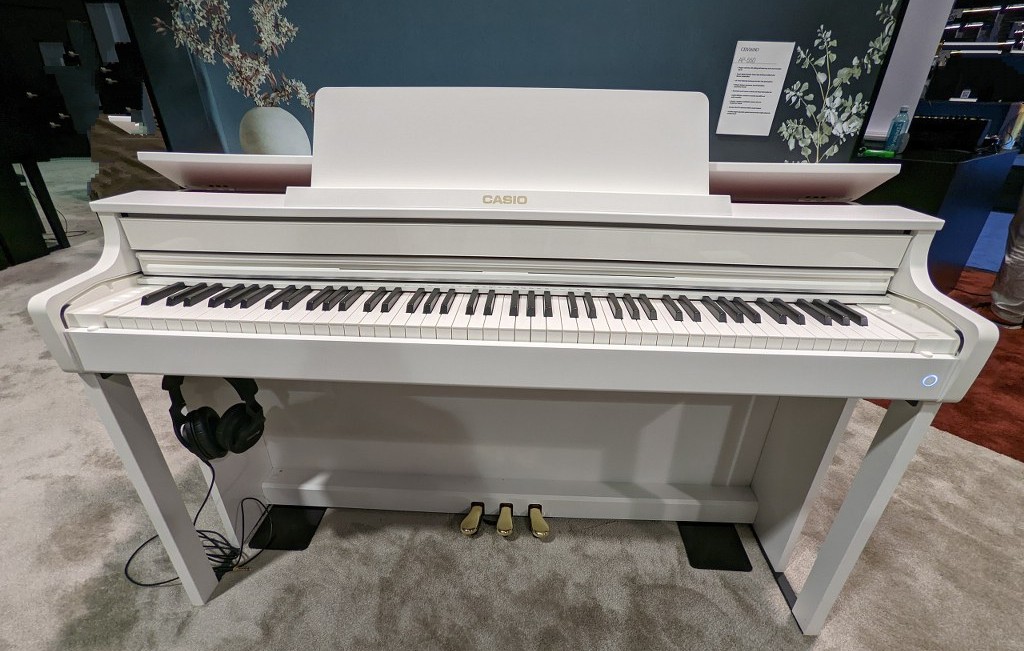
I also wanted to mention to people who have a budget of closer to $3000, that Casio has an upgraded new model above the AP-S450 called the AP-550. This model also just recently came out and it sells on-line for $2999…so it’s $1000 more than the AP-S450. I have also played it many times. There are obviously some definite differences between these 2 models and one of those noticeable differences is the cabinet.

The AP-550 also comes in the same cabinet colors as the AP-S450, but the cabinet is a bit larger measuring 55″ wide x 35″ tall, x 17″ deep. The AP-S450 is just 12′ deep from the wall, so the AP-550 is definitely larger and occupies more room. The AP-550 is also 26 lbs heavier than the AP-S450 which is due to the larger cabinet and upgraded internal speaker system.
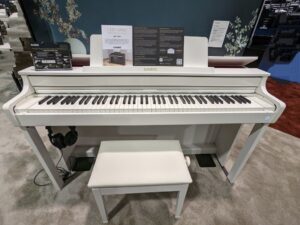 The AP-550 has front support legs on the cabinet for even more stability and adds more elegance to the overall look of the piano, and it comes with an attractive matching height adjustable padded bench, which adds to the value. The triple pedal unit on the AP-550 has longer pedals than the AP-S450 and those pedals are made of brass, so even this feature is upgraded.
The AP-550 has front support legs on the cabinet for even more stability and adds more elegance to the overall look of the piano, and it comes with an attractive matching height adjustable padded bench, which adds to the value. The triple pedal unit on the AP-550 has longer pedals than the AP-S450 and those pedals are made of brass, so even this feature is upgraded.
Unlike the AP-S450, the top lid of the AP-550 can open up with a lid prop and that open lid allows the piano sound to come out and towards the player creating a bigger and more immediate piano sound. The open lid gives you the feeling of an open lid on a grand piano. The open lid feature has a few variations and tonal changes as well that you can edit and change. So that’s pretty cool. However, you can also just keep the lid down in its normal closed position and the piano sound is still very good.
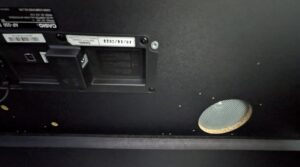 The AP-550 sound system is different inside the piano and the lower speakers are pointing down for the sound to flow out of the cabinet and bounce off the floor to create a larger piano sound with somewhat more depth than the AP-S450. The upper speakers behind the key cover are the same as in the AP-S450.
The AP-550 sound system is different inside the piano and the lower speakers are pointing down for the sound to flow out of the cabinet and bounce off the floor to create a larger piano sound with somewhat more depth than the AP-S450. The upper speakers behind the key cover are the same as in the AP-S450.
Otherwise, all the other features I talked about on the AP-S450 are the same in the AP550. So if you like what the AP-S450 can do for you with all the features and functions I mentioned, along with the Casio Music Space app, and you like the additional benefits of the new AP-550 and can afford to be in that price range, then the AP-550 should be a great option for you when it comes to investing in an impressive new digital piano.
